Journal of Southern Medical University ›› 2025, Vol. 45 ›› Issue (2): 229-238.doi: 10.12122/j.issn.1673-4254.2025.02.03
Previous Articles Next Articles
Xue SONG1( ), Yue CHEN2,4, Min ZHANG2,5, Nuo ZHANG2,5, Lugen ZUO5,6, Jing LI4,6, Zhijun GENG1, Xiaofeng ZHANG1, Yueyue WANG4, Lian WANG5, Jianguo HU4(
), Yue CHEN2,4, Min ZHANG2,5, Nuo ZHANG2,5, Lugen ZUO5,6, Jing LI4,6, Zhijun GENG1, Xiaofeng ZHANG1, Yueyue WANG4, Lian WANG5, Jianguo HU4( )
)
Received:2024-08-12
Online:2025-02-20
Published:2025-03-03
Contact:
Jianguo HU
E-mail:songxue0214@bbmc.edu.cn;jghu9200@bbmc.edu.cn
Xue SONG, Yue CHEN, Min ZHANG, Nuo ZHANG, Lugen ZUO, Jing LI, Zhijun GENG, Xiaofeng ZHANG, Yueyue WANG, Lian WANG, Jianguo HU. GPSM2 is highly expressed in gastric cancer to affect patient prognosis by promoting tumor cell proliferation[J]. Journal of Southern Medical University, 2025, 45(2): 229-238.
Add to citation manager EndNote|Ris|BibTeX
URL: https://www.j-smu.com/EN/10.12122/j.issn.1673-4254.2025.02.03
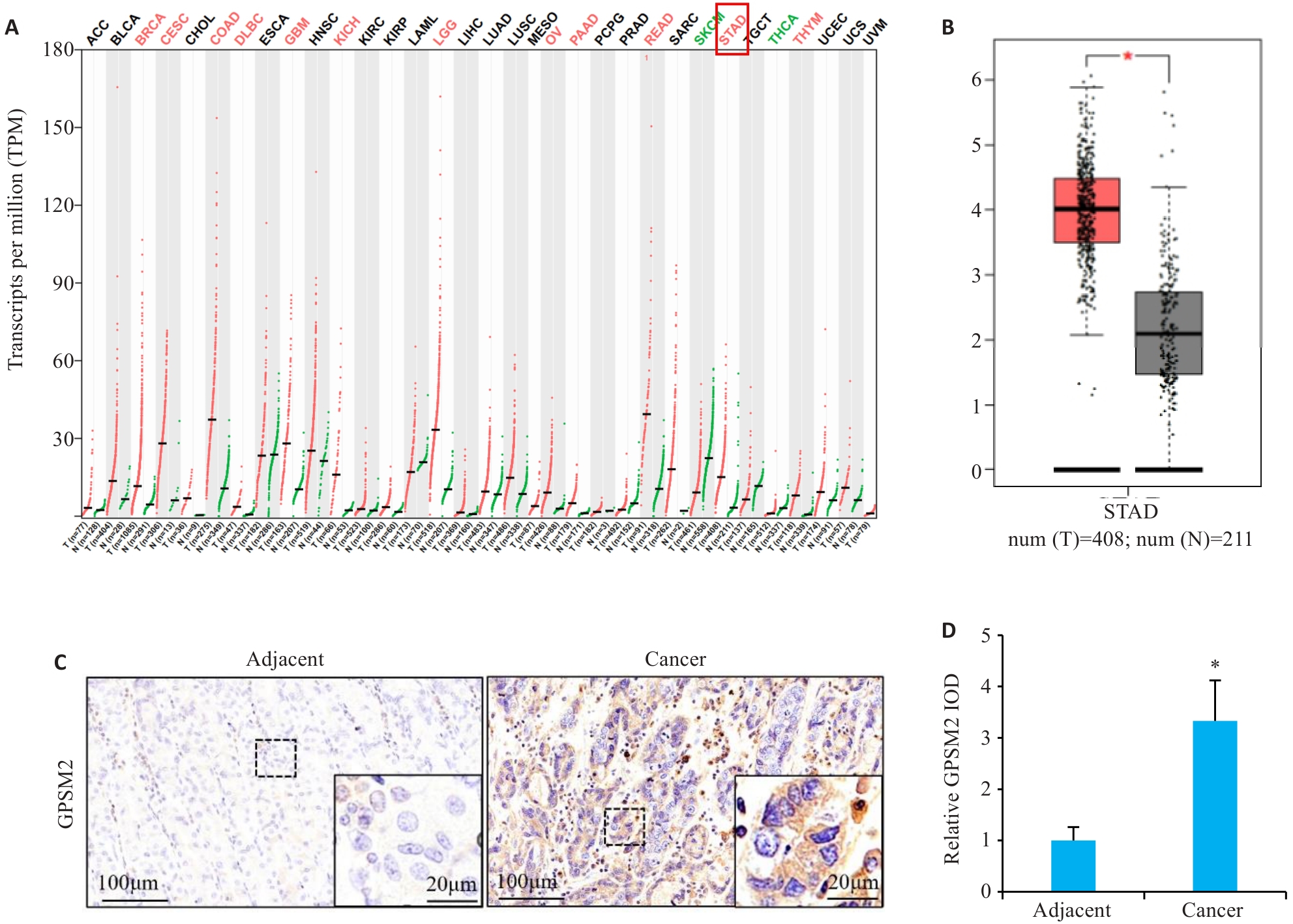
Fig.1 GEPIA is highly expressed in gastric cancer tissues. A: Expression of GPSM2 in pan-cancer. B: Expression of GPSM2 in gastric cancer. C: Immunohistochemical staining of GPSM2. D: Relative integrated optical density (IOD) value of GPSM2. *P<0.05 vs adjacent tissue.
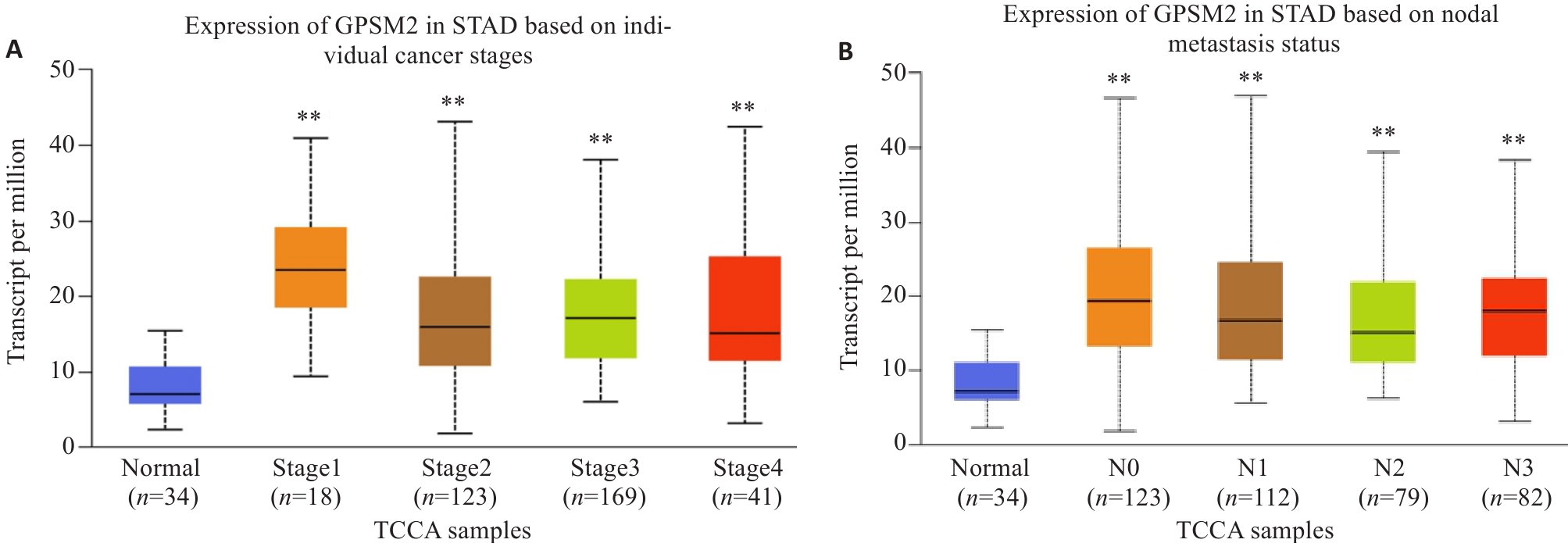
Fig.2 Association of GPSM2 expression level with clinicopathological parameters of gastric cancer patients. A, B: Expression levels of GPSM2 gene in tumor specimens with different cancer stages and lymph node metastasis status in the UALCAN database. **P<0.01 vs normal.
| Clinicopathological parameters | Number of cases | GPSM2 | χ 2 | P | |
|---|---|---|---|---|---|
Low expression (n=54) | High expression (n=55) | ||||
| Gender | 0.002 | 0.962 | |||
| Female | 87 | 43 | 44 | ||
| Male | 22 | 11 | 11 | ||
| Age (year) | 2.080 | 0.149 | |||
| <60 | 45 | 26 | 19 | ||
| ≥60 | 64 | 28 | 36 | ||
| Tumor size (cm) | 0.446 | 0.504 | |||
| <5 | 41 | 22 | 19 | ||
| ≥5 | 68 | 32 | 36 | ||
| Histological Grading | 12.759 | <0.001 | |||
| G1-G2 | 60 | 39 | 21 | ||
| G3-G4 | 49 | 15 | 34 | ||
| T Stage | 11.370 | <0.001 | |||
| T1-T2 | 59 | 38 | 21 | ||
| T3-T4 | 50 | 16 | 34 | ||
| N Stage | 4.975 | 0.026 | |||
| N0-N1 | 61 | 36 | 25 | ||
| N2-N3 | 48 | 18 | 30 | ||
| CEA (μg/L) | 14.026 | <0.001 | |||
| <5 | 49 | 34 | 15 | ||
| ≥5 | 60 | 20 | 40 | ||
| CA19-9 (kU/L) | 12.556 | <0.001 | |||
| <37 | 52 | 35 | 17 | ||
| ≥37 | 57 | 19 | 38 | ||
Tab.1 Relationship between GPSM2 expression in gastric cancer tissues and clinicopathological parameters of the patients
| Clinicopathological parameters | Number of cases | GPSM2 | χ 2 | P | |
|---|---|---|---|---|---|
Low expression (n=54) | High expression (n=55) | ||||
| Gender | 0.002 | 0.962 | |||
| Female | 87 | 43 | 44 | ||
| Male | 22 | 11 | 11 | ||
| Age (year) | 2.080 | 0.149 | |||
| <60 | 45 | 26 | 19 | ||
| ≥60 | 64 | 28 | 36 | ||
| Tumor size (cm) | 0.446 | 0.504 | |||
| <5 | 41 | 22 | 19 | ||
| ≥5 | 68 | 32 | 36 | ||
| Histological Grading | 12.759 | <0.001 | |||
| G1-G2 | 60 | 39 | 21 | ||
| G3-G4 | 49 | 15 | 34 | ||
| T Stage | 11.370 | <0.001 | |||
| T1-T2 | 59 | 38 | 21 | ||
| T3-T4 | 50 | 16 | 34 | ||
| N Stage | 4.975 | 0.026 | |||
| N0-N1 | 61 | 36 | 25 | ||
| N2-N3 | 48 | 18 | 30 | ||
| CEA (μg/L) | 14.026 | <0.001 | |||
| <5 | 49 | 34 | 15 | ||
| ≥5 | 60 | 20 | 40 | ||
| CA19-9 (kU/L) | 12.556 | <0.001 | |||
| <37 | 52 | 35 | 17 | ||
| ≥37 | 57 | 19 | 38 | ||
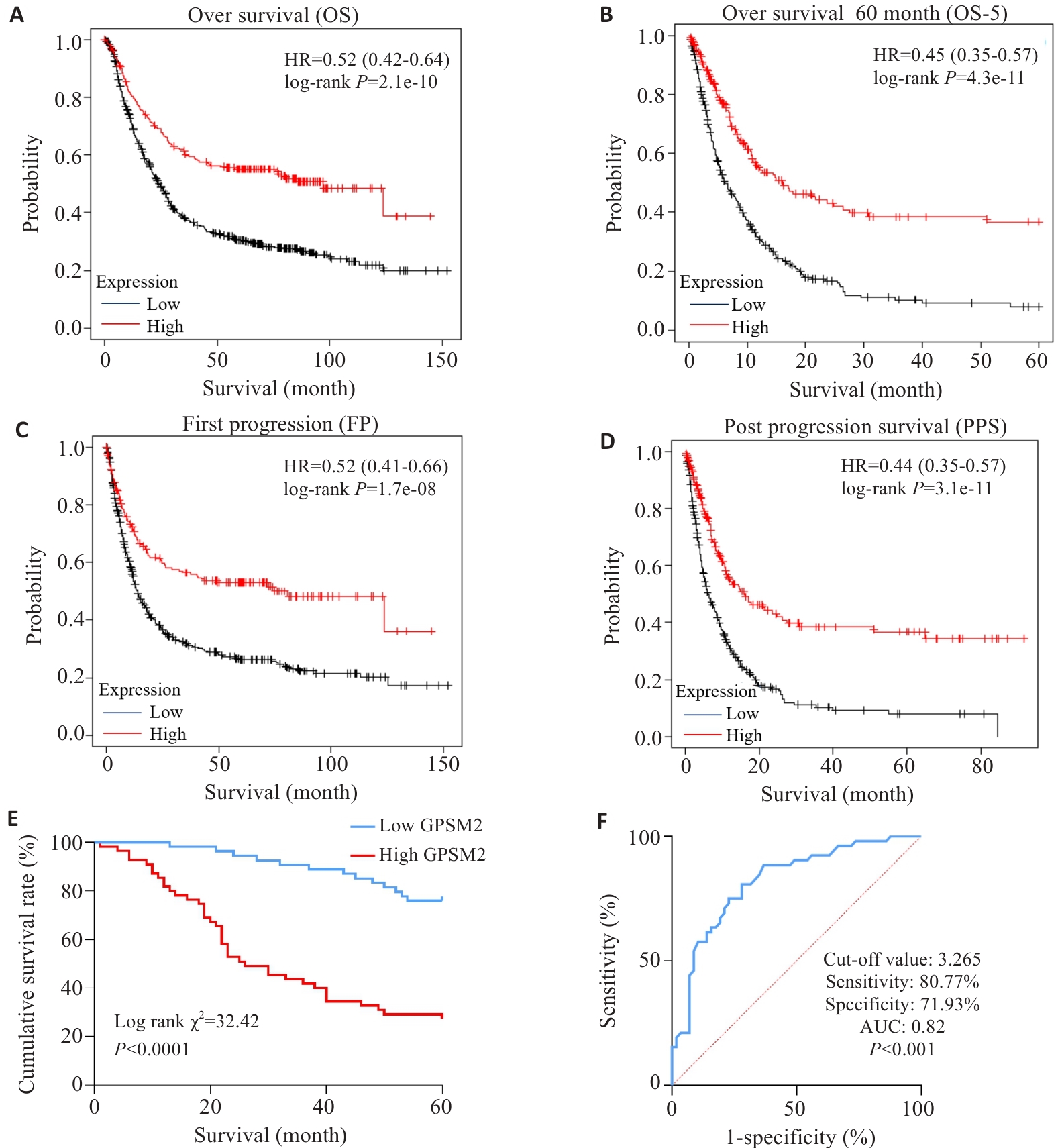
Fig.3 High GPSM2 expression levels are associated with a decreased postoperative 5-year survival rate in gastric cancer patients. A-D: Analysis of the association of GPSM2 expression levels with over survival (OS), overall survival at 60 months (OS-5), first progression (FP) and post-progression survival (PPS) using Kaplan-Meier Plotter. E: Kaplan-Meier survival analysis demonstrating the impact of GPSM2 expression on 5-year survival rate of gastric cancer patients after gastrectomy. F: ROC curve analysis for evaluating the predictive value of GPSM2 expression for 5-year survival rates in gastric cancer patients following gastrectomy.
| Clinicopathological parameters | Univariate analysis | Multivariate analysis | |||
|---|---|---|---|---|---|
| Log-rank χ2 | P | HR | 95% CI | P | |
| Gender (female vs male) | 0.157 | 0.692 | |||
| Age (≥60 year vs <60 year) | 1.188 | 0.276 | |||
| Tumor size (≥5 cm vs <5 cm) | 0.004 | 0.949 | |||
| GPSM2 expression (high vs low) | 32.418 | <0.001 | 3.365 | 1.689-6.705 | <0.001 |
| G Stage (G3-G4vs G1-G2) | 15.761 | <0.001 | 1.421 | 0.769-2.626 | 0.262 |
| T Stage (T3-T4vs T1-T2) | 26.397 | <0.001 | 3.406 | 1.762-6.584 | <0.001 |
| N Stage (N2-N3vs N0-N1) | 21.542 | <0.001 | 2.130 | 1.115-4.068 | 0.022 |
| CEA (≥5 μg/L vs <5 μg/L ) | 37.810 | <0.001 | 2.717 | 1.175-6.283 | 0.019 |
| CA19-9 (≥37 kU/L vs <37 kU/L) | 37.429 | <0.001 | 3.592 | 1.577-8.183 | 0.002 |
Tab.2 Univariate and multivariate Cox regression analysis of factors influencing 5-year survival rate of gastric cancer patients
| Clinicopathological parameters | Univariate analysis | Multivariate analysis | |||
|---|---|---|---|---|---|
| Log-rank χ2 | P | HR | 95% CI | P | |
| Gender (female vs male) | 0.157 | 0.692 | |||
| Age (≥60 year vs <60 year) | 1.188 | 0.276 | |||
| Tumor size (≥5 cm vs <5 cm) | 0.004 | 0.949 | |||
| GPSM2 expression (high vs low) | 32.418 | <0.001 | 3.365 | 1.689-6.705 | <0.001 |
| G Stage (G3-G4vs G1-G2) | 15.761 | <0.001 | 1.421 | 0.769-2.626 | 0.262 |
| T Stage (T3-T4vs T1-T2) | 26.397 | <0.001 | 3.406 | 1.762-6.584 | <0.001 |
| N Stage (N2-N3vs N0-N1) | 21.542 | <0.001 | 2.130 | 1.115-4.068 | 0.022 |
| CEA (≥5 μg/L vs <5 μg/L ) | 37.810 | <0.001 | 2.717 | 1.175-6.283 | 0.019 |
| CA19-9 (≥37 kU/L vs <37 kU/L) | 37.429 | <0.001 | 3.592 | 1.577-8.183 | 0.002 |
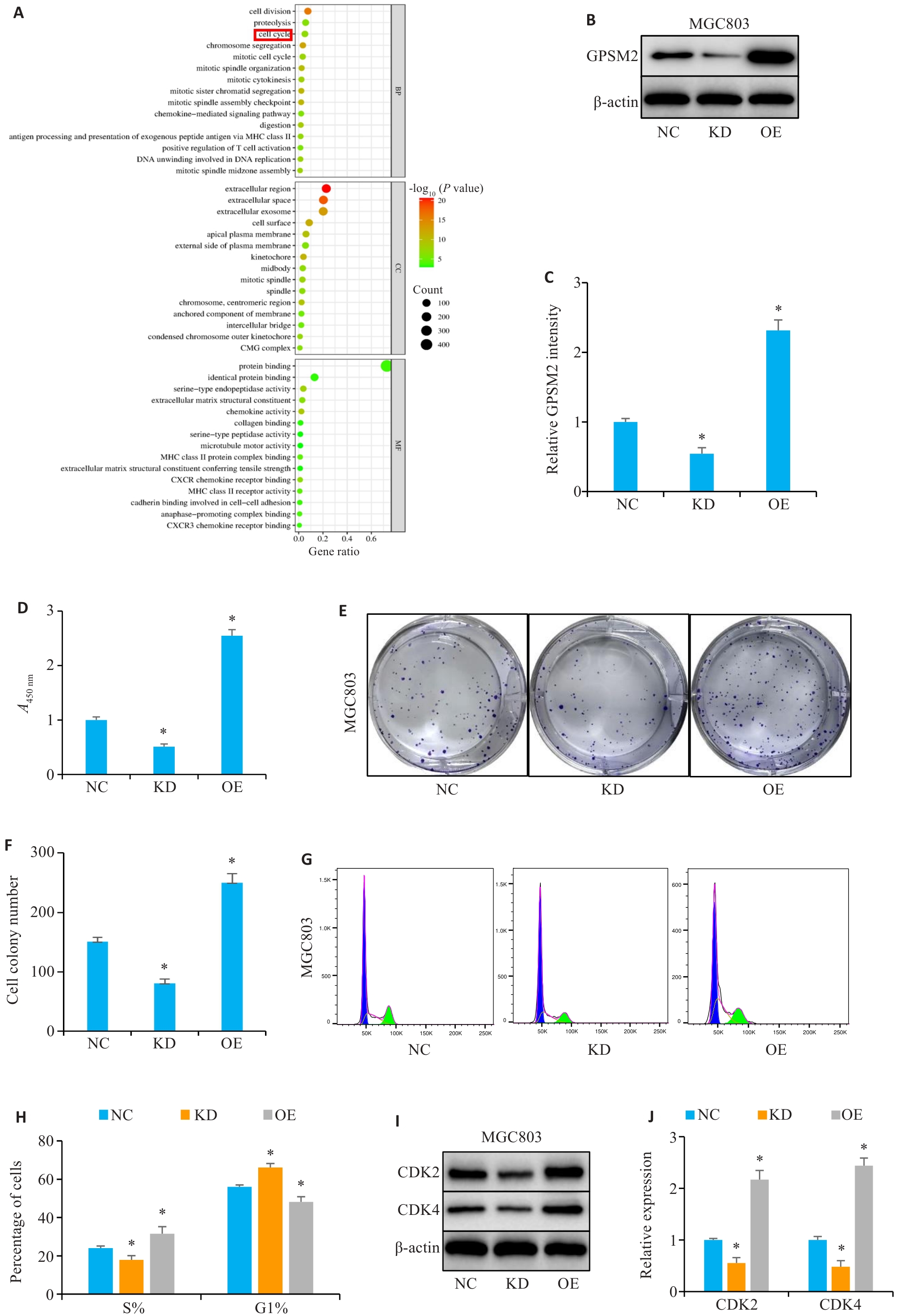
Fig.4 Effect of GPSM2 knockdown (KD) and overexpression (OE) on cell cycle of gastric cancer cells. A: GO enrichment analysis. B, C: GPSM2 protein expression in MGC803 cells analyzed by Western blotting. D: Results of CCK-8 assay. E, F: Colony-forming assay. G, H: Effect of GPSM2 on cell cycle of MGC803 cells detected by flow cytometry. I, J: Expression of CDK2 and CDK4 analyzed by Western blotting. n=3, *P<0.05 vs NC group.
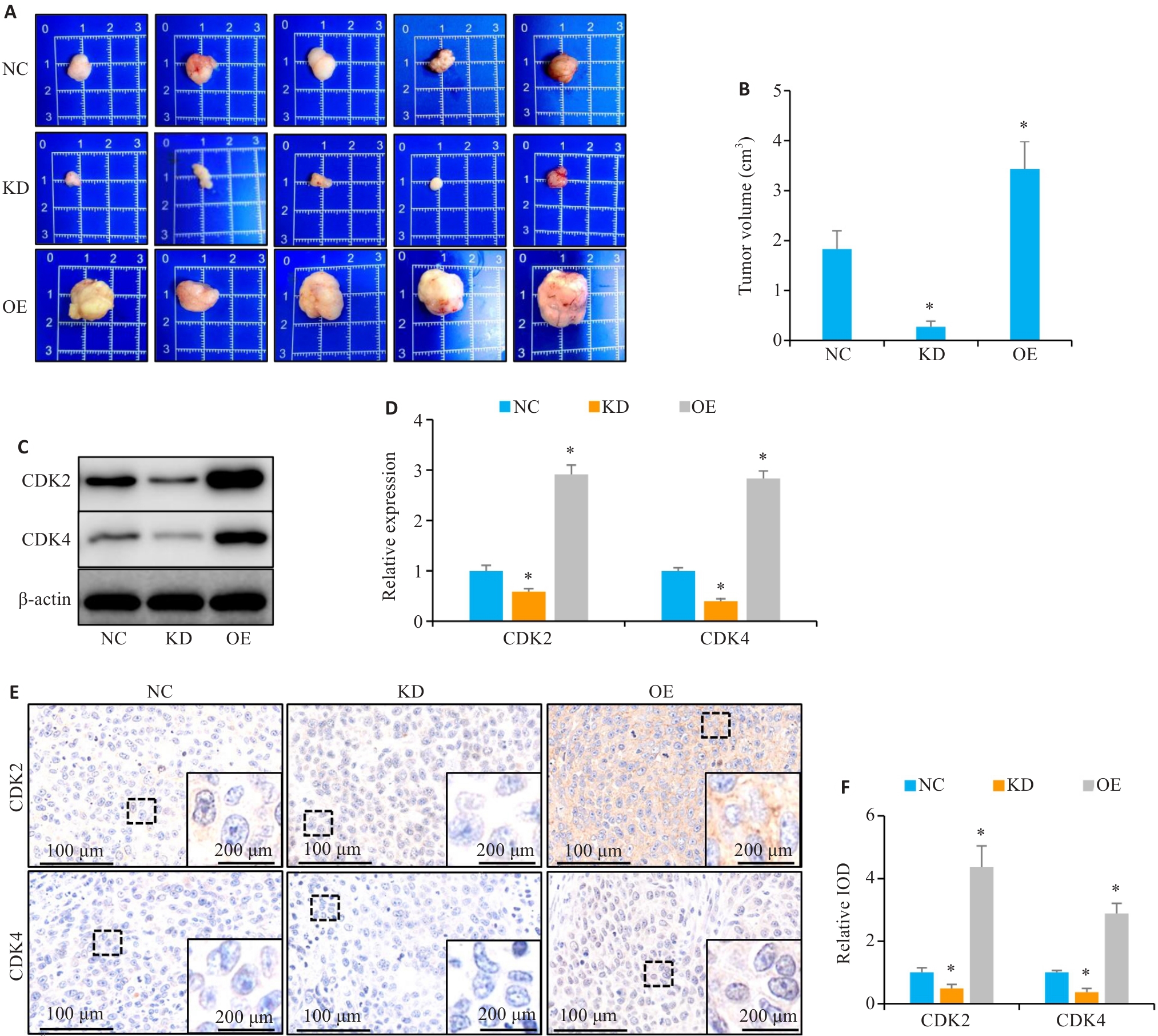
Fig.5 GPSM2 overexpression promotes subcutaneous graft tumor growth in nude mice. A: Gross observation of the dissected tumors in each group. B: Quantitative assessment of tumor volume in different groups (n=5). C, D: Expression of CDK2 and CDK4 in the xenografts. E, F: Expression of CDK2 and CDK4 in tumor tissues detected by immunohistochemical staining. n=5, *P<0.05 vs NC group.
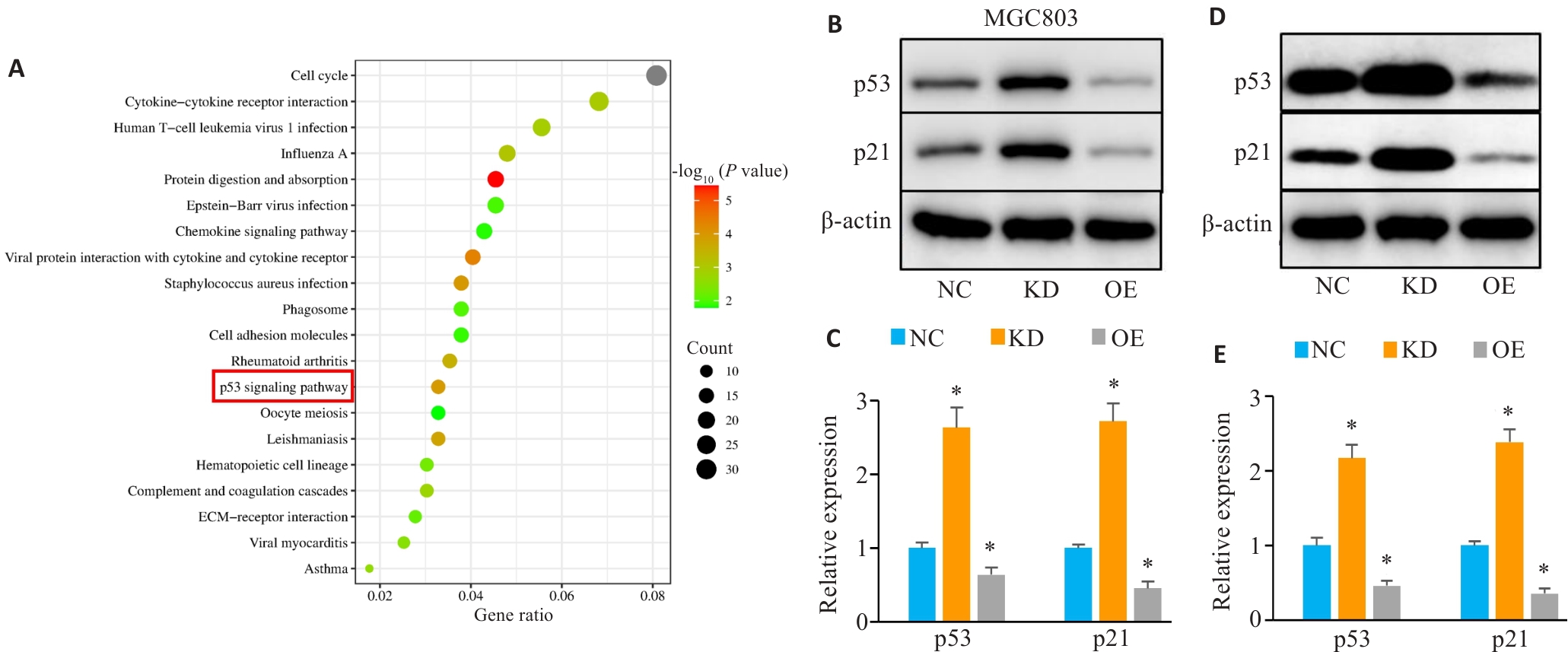
Fig.6 GPSM2 overexpression suppresses expression of the p53 signaling pathway. A: KEGG enrichment analysis. B, C: Analysis of p53 and p21 expression in different groups of MGC803 cells. D, E: Analysis of p53 and p21 expression in the transplanted tumors from nude mice. n=3, *P<0.05 vs NC group.
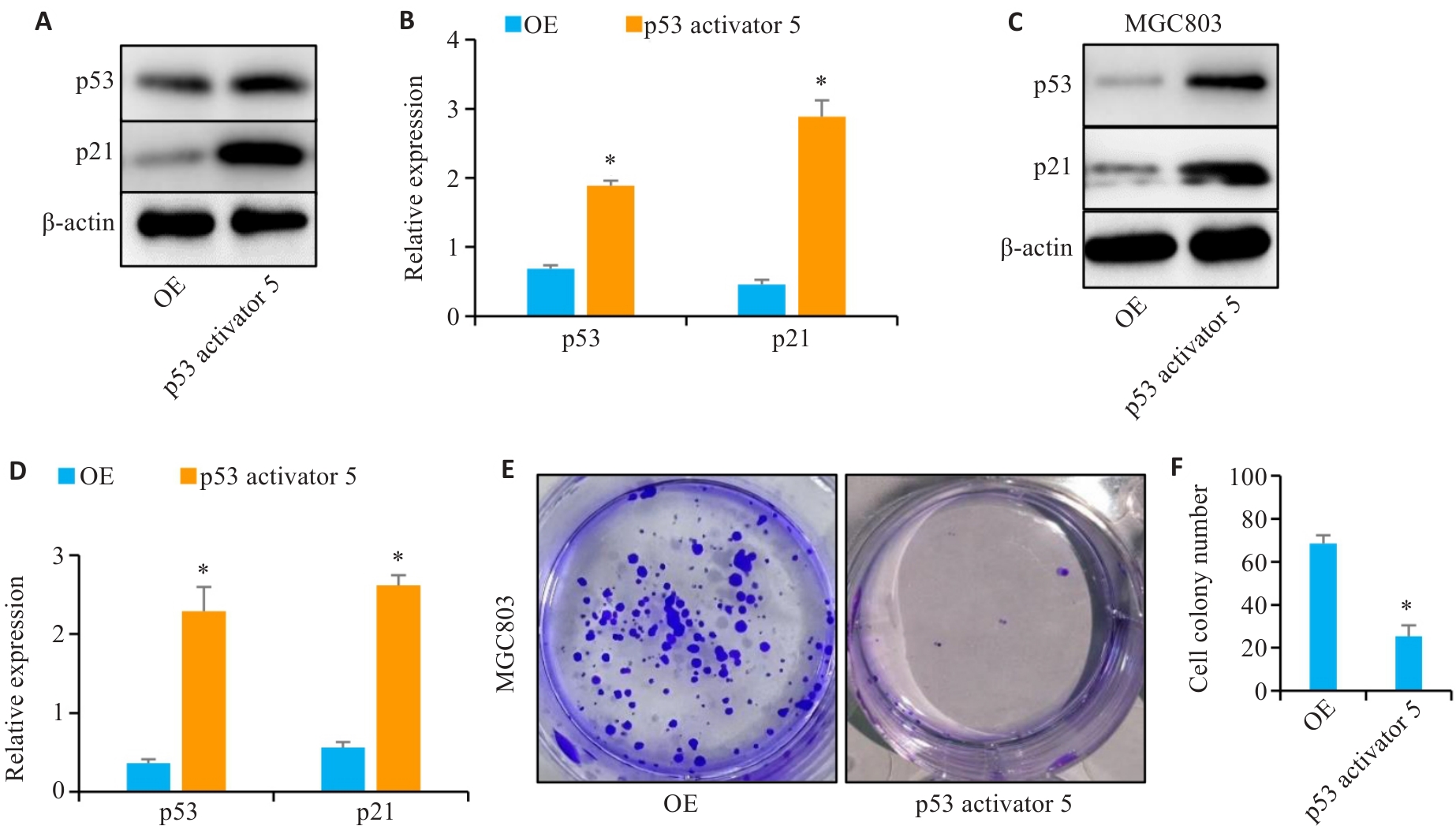
Fig.7 GPSM2 overexpression promotes proliferation of gastric cancer cells possibly by suppressing expressions of proteins in the p53 signaling pathway. A, B: Measurement of p53 and p21 expression levels in the transplanted tumors. C, D: Expression of p53 and p21 in MGC803 cells. E, F: Colony-forming assay. n=3, *P<0.05 vs OE group.
| 1 | Sung H, Ferlay J, Siegel RL, et al. Global cancer statistics 2020: GLOBOCAN estimates of incidence and mortality worldwide for 36 cancers in 185 countries[J]. CA Cancer J Clin, 2021, 71(3): 209-49. |
| 2 | Gravalos C, Jimeno A. HER2 in gastric cancer: a new prognostic factor and a novel therapeutic target[J]. Ann Oncol, 2008, 19(9): 1523-9. |
| 3 | Zhang JQ, Yin X, Wang H, et al. Development and validation of tumor marker indices in advanced gastric cancer patients[J]. Cancer Control, 2023, 30: 10732748231202466. |
| 4 | Matsuoka T, Yashiro M. Biomarkers of gastric cancer: Current topics and future perspective[J]. World J Gastroenterol, 2018, 24(26): 2818-32. |
| 5 | Xu YT, Zhang PS, Zhang KD, et al. The application of CA72-4 in the diagnosis, prognosis, and treatment of gastric cancer[J]. Biochim Biophys Acta Rev Cancer, 2021, 1876(2): 188634. |
| 6 | Hu LM, Ou XH, Shi SY. A comprehensive analysis of G-protein-signaling modulator 2 as a prognostic and diagnostic marker for pan-cancer[J]. Front Genet, 2022, 13: 984714. |
| 7 | Sriram K, Salmerón C, Wiley SZ, et al. GPCRs in pancreatic adenocarcinoma: Contributors to tumour biology and novel therapeutic targets[J]. Br J Pharmacol, 2020, 177(11): 2434-55. |
| 8 | Deng MM, Liu BF, Zhang Z, et al. Loss of G-protein-signaling modulator 2 accelerates proliferation of lung adenocarcinoma via EGFR signaling pathway[J]. Int J Biochem Cell Biol, 2020, 122: 105716. |
| 9 | Peglion F, Etienne-Manneville S. Cell polarity changes in cancer initiation and progression[J]. J Cell Biol, 2024, 223(1): e202308069. |
| 10 | Zhou Y, Wang MY, Qian Y, et al. PRDX2 promotes gastric cancer progression by forming a feedback loop with PKM2/STAT3 axis[J]. Cell Signal, 2025, 127: 111586. |
| 11 | Yang DQ, Ji FJ, Li YQ, et al. GPSM2 serves as an independent prognostic biomarker for liver cancer survival[J]. Technol Cancer Res Treat, 2020, 19: 1533033820945817. |
| 12 | Zhou XT, Dang SC, Jiang HJ, et al. Identification of G-protein signaling modulator 2 as a diagnostic and prognostic biomarker of pancreatic adenocarcinoma: an exploration of its regulatory mechanisms[J]. J Gastrointest Oncol, 2021, 12(3): 1164-79. |
| 13 | Dang SC, Qian XB, Jin W, et al. G-protein-signaling modulator 2 expression and role in a CD133+ pancreatic cancer stem cell subset[J]. Onco Targets Ther, 2019, 12: 785-94. |
| 14 | Deng MM, Zhang Z, Liu BF, et al. Localization of GPSM2 in the nucleus of invasive breast cancer cells indicates a poor prognosis[J]. Front Oncol, 2020, 10: 227. |
| 15 | 王 炼, 夏勇生, 张 震, 等. 高表达MRPL13促进胃癌细胞增殖并影响患者预后: 基于抑制p53信号[J]. 南方医科大学学报, 2023, 43(9): 1558-66. |
| 16 | Zhang WG, Liu YL, Jang H, et al. CDK2 and CDK4: cell cycle functions evolve distinct, catalysis-competent conformations, offering drug targets[J]. JACS Au, 2024, 4(5): 1911-27. |
| 17 | Yu JX, Feng HR, Sang QQ, et al. VPS35 promotes cell proliferation via EGFR recycling and enhances EGFR inhibitors response in gastric cancer[J]. EBioMedicine, 2023, 89: 104451. |
| 18 | 夏勇生, 王 炼, 陈孝华, 等. 过表达TSR2通过下调PI3K/AKT信号通路抑制胃癌细胞的增殖和侵袭[J]. 南方医科大学学报, 2024, 44(5): 913-9. |
| 19 | Tadenev ALD, Tarchini B. The spindle orientation machinery beyond mitosis: when cell specialization demands polarization[J]. Adv Exp Med Biol, 2017, 1002: 209-25. |
| 20 | Kadhim DJ, Azari H, Sokhangouy SK, et al. G-protein signaling modulator 2 as a potential biomarker in colorectal cancer: integrative analysis using genetic profiling and pan-cancer studies[J]. Genes, 2024, 15(4): 474. |
| 21 | He XQ, Zhang YF, Yu JJ, et al. High expression of G-protein signaling modulator 2 in hepatocellular carcinoma facilitates tumor growth and metastasis by activating the PI3K/AKT signaling pathway[J]. Tumour Biol, 2017, 39(3): 1010428317695971. |
| 22 | Dang HH, Ta HDK, Nguyen TTT, et al. Identifying GPSM family members as potential biomarkers in breast cancer: a comprehensive bioinformatics analysis[J]. Biomedicines, 2021, 9(9): 1144. |
| 23 | Yu JX, Zhang SG, Zhao BB. Differences and correlation of serum CEA, CA19-9 and CA72-4 in gastric cancer[J]. Mol Clin Oncol, 2016, 4(3): 441-9. |
| 24 | Feng F, Tian YZ, Xu GH, et al. Diagnostic and prognostic value of CEA, CA19-9, AFP and CA125 for early gastric cancer[J]. BMC Cancer, 2017, 17(1): 737. |
| 25 | Shibata C, Nakano T, Yasumoto A, et al. Comparison of CEA and CA19-9 as a predictive factor for recurrence after curative gastrectomy in gastric cancer[J]. BMC Surg, 2022, 22(1): 213. |
| 26 | Woodard GE, Huang NN, Cho H, et al. Ric-8A and Gi alpha recruit LGN, NuMA, and dynein to the cell cortex to help orient the mitotic spindle[J]. Mol Cell Biol, 2010, 30(14): 3519-30. |
| 27 | McCudden CR, Willard FS, Kimple RJ, et al. G alpha selectivity and inhibitor function of the multiple GoLoco motif protein GPSM2/LGN[J]. Biochim Biophys Acta, 2005, 1745(2): 254-64. |
| 28 | Fukukawa C, Ueda K, Nishidate T, et al. Critical roles of LGN/GPSM2 phosphorylation by PBK/TOPK in cell division of breast cancer cells[J]. Genes Chromosomes Cancer, 2010, 49(10): 861-72. |
| 29 | Zhang C, Liu J, Xu DD, et al. Gain-of-function mutant p53 in cancer progression and therapy[J]. J Mol Cell Biol, 2020, 12(9): 674-87. |
| 30 | Ye Y, Xie WY, Wang XP, et al. DNA-damage orchestrates self-renewal and differentiation via reciprocal p53 family and Hippo/Wnt/TGF‑β pathway activation in embryonic stem cells[J]. Cell Mol Life Sci, 2025, 82(1): 38. |
| 31 | Mao YX, Jiang P. The crisscross between p53 and metabolism in cancer[J]. Acta Biochim Biophys Sin, 2023, 55(6): 914-22. |
| [1] | Xinyuan CHEN, Chengting WU, Ruidi LI, Xueqin PAN, Yaodan ZHANG, Junyu TAO, Caizhi LIN. Shuangshu Decoction inhibits growth of gastric cancer cell xenografts by promoting cell ferroptosis via the P53/SLC7A11/GPX4 axis [J]. Journal of Southern Medical University, 2025, 45(7): 1363-1371. |
| [2] | Jinlong PANG, Xinli ZHAO, Zhen ZHANG, Haojie WANG, Xingqi ZHOU, Yumei YANG, Shanshan LI, Xiaoqiang CHANG, Feng LI, Xian LI. Overexpression of multimerin-2 promotes cutaneous melanoma cell invasion and migration and is associated with poor prognosis [J]. Journal of Southern Medical University, 2025, 45(7): 1479-1489. |
| [3] | Xuan WU, Jiamin FANG, Weiwei HAN, Lin CHEN, Jing SUN, Qili JIN. High PRELID1 expression promotes epithelial-mesenchymal transition in gastric cancer cells and is associated with poor prognosis [J]. Journal of Southern Medical University, 2025, 45(7): 1535-1542. |
| [4] | Kang WANG, Haibin LI, Jing YU, Yuan MENG, Hongli ZHANG. High expression of ELFN1 is a prognostic biomarker and promotes proliferation and metastasis of colorectal cancer cells [J]. Journal of Southern Medical University, 2025, 45(7): 1543-1553. |
| [5] | Xinrui HOU, Zhendong ZHANG, Mingyuan CAO, Yuxin DU, Xiaoping WANG. Salidroside inhibits proliferation of gastric cancer cells by regulating the miR-1343-3p-OGDHL/PDHB glucose metabolic axis [J]. Journal of Southern Medical University, 2025, 45(6): 1226-1239. |
| [6] | Yi ZHANG, Yu SHEN, Zhiqiang WAN, Song TAO, Yakui LIU, Shuanhu WANG. High expression of CDKN3 promotes migration and invasion of gastric cancer cells by regulating the p53/NF-κB signaling pathway and inhibiting cell apoptosis [J]. Journal of Southern Medical University, 2025, 45(4): 853-861. |
| [7] | Qingqing HUANG, Wenjing ZHANG, Xiaofeng ZHANG, Lian WANG, Xue SONG, Zhijun GENG, Lugen ZUO, Yueyue WANG, Jing LI, Jianguo HU. High MYO1B expression promotes proliferation, migration and invasion of gastric cancer cells and is associated with poor patient prognosis [J]. Journal of Southern Medical University, 2025, 45(3): 622-631. |
| [8] | Huali LI, Ting SONG, Jiawen LIU, Yongbao LI, Zhaojing JIANG, Wen DOU, Linghong ZHOU. Prognosis-guided optimization of intensity-modulated radiation therapy plans for lung cancer [J]. Journal of Southern Medical University, 2025, 45(3): 643-649. |
| [9] | Junjie GAO, Kai YE, Jing WU. Quercetin inhibits proliferation and migration of clear cell renal cell carcinoma cells by regulating TP53 gene [J]. Journal of Southern Medical University, 2025, 45(2): 313-321. |
| [10] | Tianwei TANG, Luan LI, Yuanhan CHEN, Li ZHANG, Lixia XU, Zhilian LI, Zhonglin FENG, Huilin ZHANG, Ruifang HUA, Zhiming YE, Xinling LIANG, Ruizhao LI. High serum cystatin C is an independent risk factor for poor renal prognosis in IgA nephropathy [J]. Journal of Southern Medical University, 2025, 45(2): 379-386. |
| [11] | Xiaorui CHEN, Qingzheng WEI, Zongliang ZHANG, Jiangshui YUAN, Weiqing SONG. Overexpression of CHMP2B suppresses proliferation of renal clear cell carcinoma cells [J]. Journal of Southern Medical University, 2025, 45(1): 126-136. |
| [12] | Yaobin WANG, Liuyan CHEN, Yiling LUO, Jiqing SHEN, Sufang ZHOU. Predictive value of NUF2 for prognosis and immunotherapy responses in pan-cancer [J]. Journal of Southern Medical University, 2025, 45(1): 137-149. |
| [13] | Chao ZHOU, Jingjing ZHANG, Qiao TANG, Shuangnan FU, Ning ZHANG, Zhaoyun HE, Jin ZHANG, Tianyi ZHANG, Pengcheng LIU, Man GONG. Value of serum tryptophan in stratified management of 90-day mortality risk in patients with hepatitis B virus-related acute-on-chronic liver failure: a multicenter retrospective study [J]. Journal of Southern Medical University, 2025, 45(1): 59-64. |
| [14] | Xiaohua CHEN, Hui LU, Ziliang WANG, Lian WANG, Yongsheng XIA, Zhijun GENG, Xiaofeng ZHANG, Xue SONG, Yueyue WANG, Jing LI, Jianguo HU, Lugen ZUO. Role of Abelson interactor 2 in progression and prognosis of gastric cancer and its regulatory mechanisms [J]. Journal of Southern Medical University, 2024, 44(9): 1653-1661. |
| [15] | Mengnan YE, Hongmei WU, Yan MEI, Qingling ZHANG. High expression of CREM is associated with poor prognosis in gastric cancer patients [J]. Journal of Southern Medical University, 2024, 44(9): 1776-1782. |
| Viewed | ||||||
|
Full text |
|
|||||
|
Abstract |
|
|||||